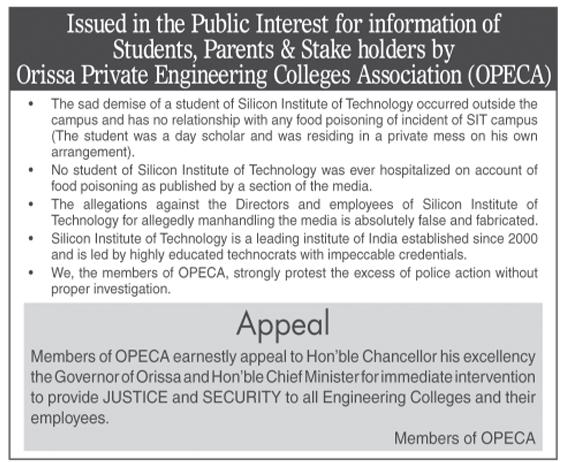Update: Apparently a student’s version is at http://whackedoutbrain.blogspot.com/2010/04/neglected-by-college-raped-by-media.html.
We have no way of verifying if the poster is a Silicon student or not. His account seems believable and the comments there suggests that other students agree with the poster.
In recent years, especially after KIIT and ITER became deemed universities, Silicon Institute of Technology in Bhubaneswar has been the top choice of students among the private engineering colleges of Odisha.
On Thursday night 22nd of April a student of Silicon died. This incident resulted in a conflict between Silicon authorities and the media and there are multiple versions of the story.
The media versions of the story can be read in:
On the other hand the Orissa Private Engineering College Association has put the advertisement given below in various newspapers. I do not know who to believe. I hope some of the students who were present during the event can shed light on what really happened.

April 24th, 2010
For additional background and the list of 123 EBBs in Odisha see https://www.orissalinks.com/archives/1689. Following is from the PIB http://pib.nic.in/release/release.asp?relid=60782.
The Cabinet Committee on Economic Affairs today approved the setting up of 1000 additional model schools as a benchmark of excellence in Educationally Backward Blocks (EBBs) through State Governments, thereby taking the total number of model schools to be set up through the State Governments to 3500.
The financial requirement for setting up 2500 schools under State Governments, which were approved by CCEA in November 2008, was estimated as Rs.9322 crore during the 11th Five Year Plan, of which the central share is Rs.7457 crore. Requirement for additional 1000 schools (current proposal) has been estimated to be Rs.3304 crore with the Central share of Rs.2478 crore. Thus the estimated Central share for establishing 3500 schools in the Government sector is Rs.9935 crore during the 11th Five Year Plan.
Each school will have 560 students, the total beneficiary for 3500 schools therefore being 19.60 lakh students. The programme will be implemented through the societies set up by the State Governments for this purpose.
The present proposal is meant for 3500 EBBs in 27 States/UTs, although the model school scheme will cover 6000 blocks in all States/UTs.
The salient features of the Scheme are as follows:
(i) Every EBB will be eligible for one model school under State Governments.
(ii) These schools to have classes from VI to XII or from IX to XII.
(iii) These schools to have norms and standards equal to or better than Kendriya Vidyalayas
(iv) Medium of instruction and affiliating board will be decided by the State Governments.
(v) 75% of the recurring and non-recurring cost, subject to scheme norms, will be borne by the Central Government except for special category states, for which the sharing pattern is 90:10.
The major impact of the scheme will be to open up access to quality secondary education to talented rural students. The scheme is expected to provide a major fillip to availability of good quality schools in rural areas, thereby nurturing talent in such areas. These schools are expected to act as pace-setting institutions and to have a demonstration effect on neighbouring schools.
April 24th, 2010
